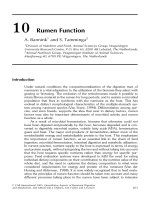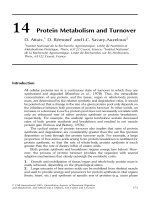Tài liệu A sociology of mental health and illness Third edition pptx
Bạn đang xem bản rút gọn của tài liệu. Xem và tải ngay bản đầy đủ của tài liệu tại đây (2.38 MB, 290 trang )
Socio-mental health pb
1/6/05
10:07 am
Page 1
T
• How have sociologists theorized and researched mental health and illness?
• In what ways do sociologists approach this topic differently to those from
other disciplines?
• How do we understand mental health problems in their social context?
This bestselling book provides a clear overview of the major aspects of the
sociology of mental health and illness, and helps students to develop a critical
approach to the subject. In this new edition, the authors update each of the
chapters, taking into consideration recent relevant literature from social science and
social psychiatry. A new chapter has been included on the impact of stigma, which
covers an analysis of the responses of the lay public to mental health and illness
and representations of mental health (particularly in the media) in a post-institutional
context.
A Sociology of Mental Health and Illness is a key teaching and learning resource for
undergraduates and postgraduates studying a range of medical sociology and
health-related courses, as well as trainee mental health workers in the fields of
social work, nursing, clinical psychology and psychiatry.
David Pilgrim is Clinical Dean, Teaching Primary Care Trust for East Lancashire
and Honorary Professor at the Universities of Liverpool and Central Lancashire. His
career has been divided between higher education and the NHS. He trained as a
clinical psychologist before completing his PhD on NHS psychotherapy. He
subsequently completed a Masters degree in Sociology. Since then he has retained
both a clinical and research interest in many aspects of mental health work.
A
I
R
D
E
D
I
T
I
S O C I O L O G Y
O
N
O F
Mental Health and
Illness
Rogers and Pilgrim
Anne Rogers is Professor of the Sociology of Health Care and currently directs a
programme of research on self-management and chronic disease management at
the National Primary Care Research and Development Centre, Division of Primary
Care, University of Manchester. Her PhD on psychiatric referrals from the police
began her academic career. Her current research interests include sociological
aspects of primary care and mental health.
A Sociology of Mental Health and Illness
A SOCIOLOGY OF MENTAL HEALTH AND ILLNESS
Third Edition
H
Cover illustration: The Cure of Madness by Hieronymus Bosch (Prado, Madrid)
Cover design: Barker/Hilsdon
ISBN 0-335-21583-1
ANNE ROGERS AND DAVID PILGRIM
9 780335 215836
A sociology of
mental health and illness
Third edition
A sociology of
mental health and illness
Third edition
Anne Rogers
and
David Pilgrim
Open University Press
Open University Press
McGraw-Hill Education
McGraw-Hill House
Shoppenhangers Road
Maidenhead
Berkshire
England
SL6 2QL
email:
world wide web: www.openup.co.uk
and Two Penn Plaza, New York, NY 10121-2289, USA
First published 2005
Copyright © Anne Rogers and David Pilgrim 2005
All rights reserved. Except for the quotation of short passages for the purposes of
criticism and review, no part of this publication may be reproduced, stored in a retrieval
system, or transmitted, in any form, or by any means, electronic, mechanical,
photocopying, recording or otherwise, without the prior written permission of the
publisher or a licence from the Copyright Licensing Agency Limited. Details of such
licences (for reprographic reproduction) may be obtained from the Copyright Licensing
Agency Ltd of 90 Tottenham Court Road, London, W1T 4LP.
A catalogue record of this book is available from the British Library
ISBN-13:
ISBN-10:
978 0335 21583 6 (pb) 978 0335 21584 3 (hb)
0335 21583 1 (pb) 0335 21584 X (hb)
Library of Congress Cataloging-in-Publication Data
CIP data applied for
Typeset by RefineCatch Ltd, Bungay, Suffolk
Printed in the UK by Bell & Bain Ltd, Glasgow
For Steven and Jack (Again!)
Contents
Preface to the third edition
Acknowledgements
1
Perspectives on mental health and illness
Chapter overview
The perspectives outwith sociology
Psychiatry
Psychoanalysis
Psychology
The statistical notion
The ideal notion
The presence of specific behaviours
Distorted cognitions
The legal framework
Conclusion about the perspectives outwith sociology
The perspectives within sociology
Social causation
Critical theory
Social constructivism
Social realism
Discussion
Questions
For discussion
Further reading
xiii
xix
1
1
2
2
4
5
5
6
7
7
8
10
11
12
12
15
16
18
22
22
22
viii
2
A sociology of mental health and illness
Stigma revisited and lay representations of mental health problems
Chapter overview
Lay views of psychological differences
Stereotyping and stigma
Intelligibility
Competence and credibility
Does labelling matter?
The role of the mass media
Social exclusion and discrimination
Social capital, social disability and social exclusion
Conclusion
Questions
For discussion
Further reading
3
Social class and mental health
Chapter overview
The general relationship between social class and health status
The relationship between social class and diagnosed mental illness
Social class, social capital and neighbourhood
The relationship between poverty and mental health status
Labour market disadvantage and mental health
Housing and mental health
Social class and mental health professionalism
Lay views about mental health and social class
Discussion
Questions
For discussion
Further reading
4
Women and men
Chapter overview
The over-representation of women in psychiatric diagnosis
Does society cause excessive female mental illness?
Vulnerability factors
Provoking agents
Symptom-formation factors
Is female over-representation a measurement artefact?
Sex differences in help-seeking behaviour
Are women labelled as mentally ill more often than men?
23
23
24
26
28
30
33
35
37
39
40
42
42
42
43
43
44
47
50
52
54
54
55
57
58
61
61
61
62
62
63
64
65
65
65
66
67
69
Contents
The effects of labelling secondary deviance – women and minor
tranquillizers
Men, dangerousness and mental health services
Gender and sexuality
Discussion
Questions
For discussion
Further reading
5
Race and ethnicity
Chapter overview
Theoretical presuppositions about race
Race and health
The epidemiology of mental health, race and ethnicity
Methodological cautions about findings
Type of service contact
Disproportionate coercion
Black people’s conduct and attributions of madness – some
summary points
Asian women and the somatization thesis
Irish people and psychiatry
Discussion
Questions
For discussion
Further reading
6
Age and ageing
Chapter overview
Emotions and primary socialization
Sociology, childhood and mental health
Childhood sexual abuse and mental health problems
Social competence in adulthood
Dementia and depression in older people
Discussion
Questions
For discussion
Further reading
ix
72
74
76
78
79
80
80
81
81
82
83
84
87
87
90
91
94
96
98
100
101
101
102
102
103
105
106
110
113
116
118
118
118
x
7
A sociology of mental health and illness
The mental health professions
Chapter overview
Theoretical frameworks in the sociology of the professions
The neo-Durkheimian framework
The neo-Weberian framework
Social closure
Professional dominance
The neo-Marxian framework
Eclecticism and post-structuralism
Mental health professionals and other social actors
Sociology and the mental health professions
Eclecticism and post-structuralism
The neo-Weberian approach
Symbolic interactionism
The influence of the sociology of deviance
The influence of the sociology of knowledge
The influence of feminist sociology
The impact of legislative arrangements and service redesign
Discussion
Questions
For discussion
Further reading
8
The treatment of people with mental health problems
Chapter overview
Therapeutics
A brief social history of psychiatric treatment
Criticisms of psychiatric treatment
Why have physical treatments tended to predominate?
Minor tranquillizers
Major tranquillizers
Antidepressants
Psychological therapies
Why is there a problem of legitimacy about the effectiveness of
psychiatric treatment?
The moral sense of ‘treatment’
Who is psychiatry’s client?
The question of informed choice
Insight
The morality of others
Comprehensive and comprehensible information
Coercion
Specifiable actions
The social distribution of treatment
120
120
121
121
122
122
122
123
124
125
127
128
132
133
134
134
135
135
137
138
139
139
140
140
141
141
143
143
145
146
149
150
151
152
153
153
154
155
156
156
156
157
Contents
The impact of evidence-based practice on treatment
Disputed evidence about ECT
Users’ views as evidence in service research
Tackling social exclusion as a focus of treatment
Governmentality and self-help
Discussion
Questions
For discussion
Further reading
9
The organization of mental health work
Chapter overview
The sociology of the hospital
The rise of the asylum
The crisis of the asylum
Responses to the crisis
The ‘pharmacological revolution’
Economic determinism
Changes in the organization of medicine: a shift to acute problems
and primary care
Community care and reinstitutionalization
Public health, primary care and the new technology revolution
Discussion
Questions
For discussion
Further reading
10
Psychiatry and legal control
Chapter overview
Legal versus medical control of madness
Mentally disordered offenders
The problematic status of personality disorder
The persistence of a problematic concept: the case of ‘dangerous and
severe personality disorder’
Socio-legal aspects of compulsion
The globalization of compulsion
Professional interests and legislation
Dangerousness
Violence and mental disorder
Suicide and mental disorder
Impact on patients of their risky image
Discussion
xi
158
159
159
160
162
163
165
166
166
167
167
168
169
172
175
176
178
179
180
185
187
189
189
190
191
191
192
193
194
198
199
201
203
204
204
208
209
210
xii
A sociology of mental health and illness
Questions
For discussion
Further reading
11
211
212
212
Users of mental health services
213
Chapter overview
The diffuse concept of service use
Relatives or ‘significant others’
Users as patients
The disregarding by researchers of those users’ views that do not
coincide with the views of mental health professionals
The notion that psychiatric patients are continually irrational and so
incapable of giving a valid view
Patients and relatives are assumed to share the same perspective, and
where they do not, the views of the former are disregarded by
researchers
Framing patient views in terms which suit professionals
Users as consumers
Literature on psychiatric patient satisfaction and dissatisfaction
Users as survivors
The phenomenology of surviving the psychiatric system
Survivors as a type of new social movement
Users as providers
The tension between advising, providing and campaigning
Discussion
Questions
For discussion
Further reading
References
Index
213
214
214
217
218
218
219
219
220
224
225
225
226
229
231
232
233
234
234
235
265
Preface to the third edition
Our first preface in 1993 emphasized that this book was A, not, The Sociology of
Mental Health and Illness. Today, more than ever, it is quite a risk to write ‘The
Sociology’ of anything. Moreover, as the wide-ranging references listed at the
end of the book indicate, we continue to draw our material from sociology but
also many other sources, including psychology and psychiatry. Sociological
analyses of our topic are not offered only by sociologists. Since the previous
edition was published in 1999, good examples of this point from other disciplines have appeared, including Richard Bentall’s Madness Explained (2003) and
Christopher Dowrick’s Beyond Depression (2004) (from psychology and medicine respectively). Both of these provide illuminating ways of exploring psychological abnormality in its social context by emphasizing historical analysis
and a close attention to the meaning of the personal accounts of people with
mental health problems.
Our development of sociological reasoning is helped by the examination
and incorporation of work in these other disciplines. Sometimes this involves
using the empirical findings of their studies to build up an argument. Sometimes it is about applying a sociological approach to their production. A further complication is that some sociologists now co-author their work with
collaborators from other disciplines and this joint work may appear in nonsociology journals. Although disciplinary silos are still often jealously protected in the academy, research in an applied and broad area like mental
health invariably leads to a range of inter-disciplinary outcomes.
As a consequence of these considerations, we cannot write a sociology book
which only refers to sociology titles (or if we did the product would be much
the poorer). However, this broad engagement with our topic means that
boundary lines have to be drawn at times. For example, our partial and partisan summary of the field means that we focus on some native concerns in
detail. This is exemplified in the chapter on race in which we overwhelmingly
dwell on the post-colonial British picture, although in many other chapters
the material would be relevant to any Anglophone audience.
We wrote the first edition of the book at the end of the 1980s when sociological debates about mental health and psychiatry were not as salient as they
xiv
A sociology of mental health and illness
had been during the 1960s and 1970s. During those earlier decades, mental
illness had been subject to considerable scrutiny and was used as an exemplar
in mainstream sociological theorizing on deviance and social control. The
popularity of sociological work about psychiatry during that ‘counter-cultural’
period was also fuelled by radical critiques from some mental health professionals, who questioned their own traditional theory and practice. While a
sociological interest in mental health continued in North America, in Britain
the 1980s witnessed sociological interest in health and illness turning more
and more to mainstream topics of physical and chronic illness. Sociology’s
reputation for being an intellectual fellow traveller of, or contributor to, ‘antipsychiatry’ had diminished. (Note: sociology was a fellow traveller but the
main drivers of ‘anti-psychiatry’ were psychiatrists.)
The sociological imagination of anti-psychiatric writers was challenged.
First there was the appearance of Anthony Clare’s urbane and reformist
Psychiatry in Dissent (1976), which defused the libertarian and Marxian
resonances of psychiatry’s critics and then by a more aggressive return to
psychiatric tradition in John Wing’s Reasoning About Madness (1978). This
contained a contemptuous attack upon the ideas of Michel Foucault. Wing’s
defence of his profession involved a dismissal of lay views of madness and an
appeal for more robust medical conceptualizations of mental disorder. This
sort of critique from those like Wing, who until then had worked collaboratively with sociologists, helped to deflate sociological confidence in the study
of mental health and illness. Goodwill between sociology and psychiatry was
also lost in these cross-disciplinary spats. The legacy of this loss is still evident today, with psychiatric texts expressing doubts about the worth of
sociological contributions to an understanding of mental health (Gelder et al.
2001).
By the late 1990s, when our second edition appeared, several contradictions
seemed to have emerged in: mental health service practices; civil society’s
interest in mental health; and the analyses sociologists deploy in understanding these social relationships. During the mid-1990s the topics of mental
health and illness enjoyed some rekindled sociological attention. Consumerism and user participation within the NHS and wider society found a
particularly strong voice within mental health campaigns.
Sociological work on the problematic history of institutionalization and
deinstitutionalization and women’s mental health were re-invigorated by a
series of government social policy considerations, as well as by the rise of
feminist ideas within community care debates. At the same time, within
psychiatry, biological ideas had found a fresh vigour, with a renewed interest
and enthusiasm for psychopharmacology, hi-tech brain photography and
behavioural genetics.
Reflecting on the ‘decade of the brain’, an academic champion of biological
psychiatry, Samuel Guze (1989) had asked the rhetorical question, ‘biological
psychiatry: is there any other kind?’. If this sort of triumphalist conclusion had
been genuinely warranted by evidence, then, it would seem, decades of
socially informed correctives to bio-reductionism had all been in vain. After its
professional dismissal as a therapeutic abomination, psychosurgery, which
involves the destruction of healthy brain tissue, returned to respectability
within NHS medical practice. Despite recurrent hostile user campaigns ECT
remained the ‘treatment of choice’ for severe and intractable depression. These
Preface
xv
were powerful signals that the cognitive interests of the psychiatric profession
were still driving a bio-medical orthodoxy.
While pharmaceutical research and marketing stabilized this trend, the continuing zeal of many psychiatrists for electricity and even the scalpel showed
that drug company profit alone could not explain the position championed
and enjoyed by Guze and others. The latter included psychiatric historians,
like Edward Shorter (1998: vii), who argued that:
. . . if there is one central intellectual reality (sic) at the end of the twentieth century, it is that the biological approach to psychiatry – treating
mental illness as a genetically influenced disorder of brain chemistry – has
been a smashing success.
Shorter’s confident claim begs the question: ‘smashing success for whom?’.
Has it been a ‘smashing success’ according to patients or psychiatrists or politicians or the majority of us, who are sane by mutual consent, or the pharmaceutical industry? These are both common-sense and sociological questions
because they indicate communities of interest with potentially competing
aims and views of reality. But scientism and bio-reductionism within psychiatry have not gone unchallenged in mental health debates in recent years.
Some critical psychiatrists have argued that we have come to live in a postpsychiatric society and that their own profession can ‘no longer claim any
privileged understanding of madness, alienation or distress’ (Bracken and
Thomas 1998). ‘Post-psychiatry’, rather than ‘anti-psychiatry’, now coexists in
tension with mainstream bio-medical views.
Additionally, a further trend we noted at the time of writing the second
edition was the increasing integration of sociological ideas about mental
health and illness with those from other disciplines concerned with mental
health. For example, feminist psychologists have drawn on social history and
social constructionism to analyse gender and mental health. In mental health
nursing there was, and continues to be, evidence of the integration of key
concepts associated with the sociological analysis of mental health.
The increasing salience of the ‘psy complex’ and the popularity of sociological analyses, which focus on the ontological status of emotions and
intimacy in everyday life, currently sit alongside evidence of the increasing
social exclusion and stereotyping of people with severe and enduring mental
health problems. The rise in popularity of counselling, psychological therapies and psychoanalytical ideas and the ‘regulatory systems’ in contemporary
society, which promote rather than crush subjectivity (Miller and Rose 1988),
have extended into the arenas of primary care and self management. And yet,
the old ‘anti-psychiatric’ targets (including for the early Foucault) are still
evident about coercive control and surveillance, in new service developments, such as ‘assertive outreach’ and the ‘care programme approach’, ‘early
intervention for psychosis’ and the extension of legal measures of control to
community settings. A concern with risk, which pervades sociological and
cultural analysis generally, has found a peculiar expression in the mental
health field.
Research has consistently demonstrated the importance of social support
networks and employment in the community and the risk to mental health
when these are absent. However, as work we summarize in Chapters 2 and 10
xvi
A sociology of mental health and illness
shows, public, media and politician concerns have focused unduly on the
actual or assumed risk from psychiatric patients.
This prejudicially narrow focus on risky patients by several powerful interest
groups contributes to the stigmatization and social exclusion of all people with
mental health problems. An ethical imperative then arises for students of
mental health and illness to generate a knowledge-based corrective. The latter
points up the evidence we have that people with mental health problems are
at risk of victimization in their childhood, in the patient role during service
contact, and when living in open community settings. It also highlights that
mental status is not a particularly good predictor of violence.
In his Unhealthy Societies, Richard Wilkinson (1996) has demonstrated
many aspects of the relationship between agency and structure in understanding health inequalities. Social analyses of this type can provide a rich
conceptual basis for understanding the inter-play between self-identity, personal experience and the social circumstances which generate variations in
well-being. They provide us with some confidence both to avoid the seduction of common stereotypes of decontextualized risky individuals and to
understand how patients survive as precarious agents in risky life circumstances. In the final chapter of the book, we draw attention to what Bernard
Williams, the moral philosopher, called an ‘effort at identification’, when
trying to understand the lives of psychiatric patients. It is only through that
effort that a proper sociological analysis of mental health problems can be
furnished.
Moving from patient narratives to their wider social context, since the mid1990s, globalization has been of increasing interest to sociologists (and many
others). Definitions of it vary but, broadly, it includes both an economic trend
of trans-national domination by a limited number of capitalist organizations
and a cultural trend of international convergence and homogenization (‘the
global village’) – enabled by changes in technology such as the World Wide
Web and the speed and availability of air transport. The emergence of the ‘antiglobalization’ movement largely reflects provoked opposition to the first of
these. The second trend has found its advocates and critics on both the
political left and right.
Of particular interest for the topic of this book is the World Health Organization’s Report on mental health (WHO 2001). This strongly advocates the universalization of key features of mental health provision irrespective of cultural,
social or economic context.
The World Health Report 2001 provides a new understanding of mental
disorders that offers new hope to the mentally ill and their families in all
countries and all societies . . . It examines the scope of prevention and the
availability of, and obstacles to, treatment. It deals in detail with service
provision and planning; and it concludes with a set of far-reaching
recommendations that can be adapted by every country according to its
needs and its resources.
In suggesting a universally applicable list of recommendations, the WHO
Report represents a development, which has the powerful potential to affect
polices on mental health and illness across the globe. In the USA, President
Bush has already endorsed those referring to mass community screening for
Preface
xvii
mental health problems and increases in psychotropic drug availability. Other
recommendations relate to providing treatment in primary care, providing
care in the community, educating the public about mental health, involving
communities, families and consumers, developing national policies, programmes and legislation, developing human resources (training), linking with
other agencies, monitoring treatment and prevention and undertaking more
research.
The WHO document excludes culturally specific ways of managing mental
distress and consolidates a medicalized approach to mental health, which prioritizes the use of psychotropic drugs as the first line of treatment. It reproduces an ideology of progress based upon the greater availability for all of
medical solutions to complex psycho-social problems. Its emphasis on legislation for all implies that laws enabling professionals to lock up others without
trial and interfere with their bodies without fear of prosecution for common
assault are unquestionably a sign of social advancement. The concurrent
emphasis in the document on the involvement of users and carers also mirrors
the contradictions in current mental health policies of more developed
societies.
This ‘more of the same’ position contains important silences about psychological distress as a pathway into social understanding and to the power
struggle between professional tribes and between professionals and mental
health service users. The pharmaceutical industry is presented as a neutral
supplier of much-needed products, as if its profit seeking has had no role in
shaping the landscape of mental health services. The emphasis on screening is
consistent with an old public health ideology of state surveillance. Within the
WHO model there is no consideration of the peculiar ethical and political role
of psychiatry in its normal routines.
Finally, we note the recent trend of re-examining an old and unresolved
problem for the human sciences – the relationship between psyche and soma.
Questions about the legitimacy of mental and physical illness have been
revitalized by recent debates about the problematic nature of so called ‘medically unexplained symptoms’. The split between mind and body fits uneasily
with the way in which problems are articulated and expressed by patients.
The preference from many patients for the presentation of distress as neither
simply physical nor simply mental is clearly shown by explorations of ‘depression’. The latter has been found to be grounded both in the materiality of the
body and immersed in subjective experiences and the social contexts of
women’s lives (Burt and Chapman 2004). (We explore this point further in
Chapter 4.) Also, descriptions of essentially physical complaints, such as musculoskeletal problems, suggest a lack of clear demarcation between pain
located in specific parts of the body and broader social and personal concerns. At the same time, people with these conditions may be unwilling to
recognize these concerns as ‘depression’ or ‘psychological distress’ (Rogers and
Allison 2004).
The failure to be commensurate with the Western Cartesean dualism or the
‘mind/body split’ poses a problem for disciplinary knowledge within medicine. It also creates health service challenges about ‘condition management’.
Those who are unable to articulate their problem as either a physical or a
mental one are caught in an existential limbo. They then experience an extra
vulnerability when faced with forms of professional knowledge and service
xviii
A sociology of mental health and illness
organization, which are ill equipped to respond helpfully. The primary care
system is left to contain biopsychosocial distress, often without recourse to the
quantity and quality of palliation available to those designated with clear
physical problems on the one hand or psychiatric problems on the other (May
et al. 2004).
We hope that the updated text in this new edition reflects and records the
implications of these changes in various chapters. The chapter topics, with
some slight rewording of some titles, are the same as in the previous edition,
with one exception. In recognition of the rekindled sociological interest in
stigma and social exclusion, we have introduced a new dedicated chapter.
Anne Rogers
David Pilgrim
Acknowledgements
We are grateful for the many sources of feedback, from course tutors and published reviews, passed on to us by Open University Press about the previous
edition of this book. The extensive and constructive advice offered to us from
Mick Carpenter at the University of Warwick and two other anonymous
reviewers to improve the text has been particularly appreciated. Thanks are
also offered to our colleagues at the Universities of Liverpool and Manchester
and, of course, the many students who have bought the book over the past
decade and justified the production of this new edition.
Anne Rogers
David Pilgrim
Chapter 1
Perspectives on mental health
and illness
Chapter overview
This chapter will make some necessary conceptual clarifications about the
question of terminology. Our assumption at the outset is that terminology
remains such a controversial issue for the sociology of mental health and
illness because there are markedly differing ways of speaking about mental
normality and abnormality in contemporary society. Rather than assuming
that there are competing claims about the same issue, or set of issues, we need
to take a step back and check on different frameworks of understanding. In
other words, what perspectives or discourses do we need to understand at the
outset about normal and abnormal mental life?
The chapter will cover the following four perspectives outwith sociology:
• psychiatry;
• psychoanalysis;
• psychology;
• the legal framework.
The lay view is dealt with in the next chapter because of its importance to
understanding public responses to mental health problems. Labelling theory
(societal reaction theory) will also be dealt with in the next chapter.
This chapter will then cover the following four-perspectives within
sociology:
• social causation;
• critical theory;
• social constructivism;
• social realism.
2
A sociology of mental health and illness
The perspectives outwith sociology
Psychiatry
We start with psychiatry because it has been the dominant discourse. Accordingly, it has shaped the views of others or has provoked alternative or opposing perspectives. While psychiatric patients (Rogers, Pilgrim and Lacey 1993)
and those in multi-disciplinary mental health teams (Colombo et al. 2003)
evince a complex range of views about the nature of mental disorder, each of
these models competes for recognition and authority alongside the traditional
and dominant medical approach deployed by psychiatry
Psychiatry is a speciality within medicine. Its practitioners, as in other specialties, are trained to see their role as identifying sick individuals (diagnosis),
predicting the future course of their illness (prognosis), speculating about its
cause (aetiology) and prescribing a response to the condition, to cure it or
ameliorate its symptoms (treatment). Consequently, it would be surprising if
psychiatrists did not think in terms of illness when they encounter variations
in conduct which are troublesome to people (be they the identified patient or
those upset by them). Those psychiatrists who have rejected this illness
framework, in whole or in part, tend to have been exposed to, and have
accepted, an alternative view derived from another discourse (psychology,
philosophy or sociology).
As with other branches of medicine, psychiatrists vary in their assumptions
about diagnosis, prognosis, aetiology and treatment. This does not imply,
though, that views are evenly spread throughout the profession, and as we will
see later in the book, modern Western psychiatry is an eclectic enterprise. It
does, however, have dominant features. In particular, diagnosis is considered
to be a worthy ritual for the bulk of the profession and biological causes are
favoured along with biological treatments.
This biological emphasis has a particular social history, which is summarized in Chapter 8. However, this should not deflect our attention from the
capacity of an illness framework to accommodate multiple aetiological factors.
For instance, a psychiatrist treating a patient with antidepressant drugs may
recognize fully that living in a high-rise flat and being unemployed have been
the main causes of the depressive illness, and may assume that the stress
this induces has triggered biochemical changes in the brain, which can be
corrected by using medication.
The illness framework is the dominant framework in mental health services
because psychiatry is the dominant profession within those services (see
Chapter 8). However, its dominance should not be confused with its conceptual superiority. The illness framework has its strengths in terms of its
logical and empirical status, but it also has many weaknesses. Its strengths lie
in the neurological evidence about madness: bacteria and viruses have been
demonstrably associated with madness (syphilis and encephalitis). Such a
neurological theory might be supported further by the experience and behaviour of people with temporal lobe epilepsy, who may present with anxiety
and sometimes florid psychotic states. The induction of abnormal mental
states by brain lesions, drugs, toxins, low blood sugar and fever might all point
to the sense in regarding mental illness as a predominantly biological condition.
Perspectives on mental health and illness
3
The question begged is: what has medicine to do with that wide range of
mental problems that elude a biological explanation? Indeed, the great bulk of
what psychiatrists call ‘mental illness’ has no proven bodily cause, despite
substantial research efforts to solve the riddle of a purported or assumed biological aetiology. These illnesses include anxiety neuroses, reactive depression
and functional psychoses (the schizophrenias and the affective conditions of
mania and severe or endogenous depression). While there is some evidence
that we may inherit a vague predisposition to nervousness or madness, there
are no clear-cut laws evident to biological researchers as yet. Both broad
dispositions run in families, but not in such a way as to satisfy us that they are
biologically caused. Upbringing in such families might equally point to
learned behaviour and the genetic evidence from twin studies remains
contested (Marshall 1990).
It may be argued that biological treatments that bring about symptom relief
themselves point to biological aetiology (such as the lifting of depression by
ECT or the diminution of auditory hallucination by major tranquillizers).
However, this may not follow: thieving can be prevented quite effectively by
chopping off the hands of perpetrators, but hands do not cause theft. Likewise,
a person shocked following a car crash may feel better by taking a minor
tranquillizer, but their state is clearly environmentally induced. The thief’s
hands and the car crash victim’s brain are merely biological mediators in a
wider set of personal, economic and social relationships. Thus, effective biological treatments cannot be invoked as necessary proof of biological
causation.
A fundamental problem with the illness framework in psychiatry is that it
deals, in the main, with symptoms, not signs. That is, the judgements made
about whether or not a person is mentally ill or healthy focus mainly (and
often singularly) on the person’s communications. This is certainly the case in
the diagnosis of neurosis and the functional psychoses. Even in organic conditions, such as dementia, brain damage is not always detectable post-mortem
(see Chapter 6). In the diagnosis of physical illness the diagnosis can often
be confirmed using physical signs of changes in the body (e.g. the visible
inflammation of tissue as well as the patient reporting pain).
However, it is possible to overdraw the distinctions between physical and
mental illness. For example, an internal critic of psychiatry, Thomas Szasz
(1961), has argued that mental illness is a myth. He says that only bodies can
be ill in a literal sense and that minds can only be sick metaphorically (like
economies). And yet, as we noted earlier, physical disturbances can sometimes
produce profound psychological disturbances. Given that emotional distress
has a well-established causative role in a variety of psychosomatic illnesses,
like gastric ulcers and cardiovascular disease, the mutual inter-play of mind
and body seems to be indicated on reasonable grounds.
It is true (following Szasz 1961) that the validity of mental diagnosis is
undermined more by its over-reliance on symptoms and by the absence of
detectable bodily signs, but this can apply at times even in physical medicine.
For instance, a person may feel very ill with a headache but it may be impossible to appeal to signs to check whether or not this is because of a toxic
reaction, for instance a ‘hangover’, or a brain tumour. Also, people with
chronic physical problems have much in common, in terms of their social
role, with psychiatric patients – both are disabled and usually not valued by
4
A sociology of mental health and illness
their non-disabled fellows. Finally, the absence of a firm biological aetiology is
true of a number of physical illnesses, such as multiple sclerosis. Thus, the
conceptual and empirical uncertainties that Szasz draws our attention to, legitimately, about mental illnesses, can apply also to what he considers to be ‘true
illnesses’.
A final point to note about the biological emphasis in psychiatry is that it
has been repeatedly challenged by a minority of psychiatrists, including but
not only Szasz. For example, some retain diagnosis but reject narrow biological
explanations. They prefer to offer a biopsychosocial model which takes into
account social circumstances and biographical nuances (Engel 1980; Pilgrim
2002a). Others have argued that madness is intelligible provided that the
patient’s social context is fully understood (Laing and Esterson 1964). More
recently some psychiatrists have embraced social constructivism and argued
that their profession has no privileged understanding of mental disorder. This
emerging ‘post-psychiatry’ ‘emphasizes social and cultural contexts, places
ethics before technology and works to minimize medical control of coercive
interventions’ (Bracken and Thomas 2001: 725).
Psychoanalysis
Psychoanalysis was the invention of Sigmund Freud. It has modern
adherents who are loyal to his original theories but there are other trained
analysts who adopt the views of Melanie Klein; others take a mixed position, borrowing from each theory. Thus, psychoanalysis is an eclectic or
fragmented discipline. Its emphasis on personal history places it in the
domain of biographical psychology. Indeed, Freud’s work is sometimes
called depth or psychodynamic psychology, along with the legacies of his
dissenting early group such as Jung, Adler and Reich. Depth psychology
proposes that the mind is divided between conscious and unconscious parts
and that the dynamic relationship between these gives rise to
psychopathology.
Like other forms of psychology, psychoanalysis works on a continuum
principle – abnormality and normality are connected, not disconnected and
separate. To the psychoanalyst we are all ill to some degree. However, the
medical roots of psychoanalysis and the continued dominance of medical
analysts within its culture have, arguably, left it within a psychiatric, not
psychological, discourse. It still uses the terminology of pathology (‘psychopathology’ and its ‘symptoms’); assessments are ‘diagnostic’ and its clients
‘patients’; people do not merely have ways of avoiding human contact, they
have ‘schizoid defences’ and they do not simply get into the habit of angrily
blaming others all of the time, instead they are ‘fixated in the paranoid position’. The language of psychoanalysis is saturated with psychiatric terms.
Thus, the discipline of psychoanalysis stands somewhere between psychiatry
and psychology.
Psychoanalysis, arguably, has two strengths. First, it offers a comprehensive
conceptual framework about mental abnormality. Once a devotee accepts its
strictures, it offers the comfort of explaining, or potentially explaining, every
aspect of human conduct. Second, there is a symmetry between its causal
theory and its corrective programme. That which has been rendered









